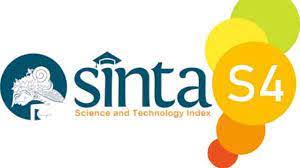REMOTE CONTROLLED LIGHT BERBASIS ARDUINO MENGGUNAKAN METODE FUZZY LOGIC
Abstract
Tujuan dari berkembangnya teknologi adalah untuk membantu manusia. Dengan teknologi pekerjaan yang sulit akan terasa lebih mudah dalam implementasinya. Saat ini berbagai teknologi telah dikembangkan, salah satunya adalah konsep objek untuk mengirim data tanpa melalui interaksi antara manusia, hal ini sangat berguna untuk membantu kaum disabilitas dalam melakukan aktifitas seperti menyalakan lampu dan aktifitas lainnya yang sulit dilakukan bagi kaum disabilitas.
Penelitian yang dilakukan ini adalah menciptakan sebuah aplikasi pengendalian jarak jauh untuk pengontrolan lampu dengan menggunakan remote control. Remote dikendalikan dengan aplikasi arduino dan inframerah. Alat ini yang dibangun menggunakan metode kecerdasan buatan yaitu logika fuzzy dengan mengunakan dua parameter yaitu suhu dan keadaan tingkat cahaya sekitar untuk mengatur intensitas lampu.
Hasil penelitian ini akan memberikan solusi tepat guna bagi berbagai pihak yang akan menimplementasikan sistem kendali jarak jauh.
References
M. Coeckelbergh, “Technology and the good society:A polemical essay on socialontology, political principles, and responsibility for technology,”Technology in Society,vol. 52, pp. 4 – 9, 2018, technology and the Good Society. [Online]. Available:http://www.sciencedirect.com/science/article/pii/S0160791X16301191
Y.-H. Wang and C.-C. Hsieh,“Explore technology innovation and intelligencefor iot (internet of things) based eyewear technology,”Technological Forecast-ing and Social Change,vol. 127,pp. 281 – 290,2018. [Online]. Available:http://www.sciencedirect.com/science/article/pii/S0040162516304383
S. F. Pane, R. M. Awangga, and B. R. Azhari, “Qualitative evaluation of rfid implementationonwarehouse management system,”TELKOMNIKA (Telecommunication Computing Electronicsand Control), vol. 16, no. 3, 2018.
R. M. Awangga, N. S. Fathonah, and T. I. Hasanudin, “Colenak: GPS tracking modelfor post-stroke rehabilitation program using AES-CBC URL encryption and QR-Code,” in2017 2nd International conferences on Information Technology, Information Systems andElectrical Engineering (ICITISEE).IEEE, nov 2017, pp. 255–260. [Online]. Available:http://ieeexplore.ieee.org/document/8285506/
R. M. Awangga, S. F. Pane, K. Tunnisa, and I. S. Suwardi, “K means clustering and mean-shift analysis for grouping the data of coal term in puslitbang tekmira,”TELKOMNIKA(Telecommunication Computing Electronics and Control), vol. 16, no. 3, 2018.
I. N. Yulita, S. Purwani, R. Rosadi, and R. M. Awangga, “A quantization of deep beliefnetworks for long short-term memory in sleep stage detection,” inAdvanced Informatics,Concepts, Theory, and Applications (ICAICTA), 2017 International Conference on. IEEE,2017, pp. 1–5.
J. Drapela, R. Langella, J. Slezingr, and A. Testa, “Generalized lamp model for light flickerstudies,”Electric Power Systems Research, vol. 154, pp. 413 – 422, 2018. [Online]. Available:http://www.sciencedirect.com/science/article/pii/S0378779617303747
V. A. Balogun, B. I. Oladapo, A. O. Adeoye, J. F. Kayode, and S. O. Afolabi, “Hysteresisanalysis of thornton (ip6, ip12e and th5v) magnetic materials through the use of arduinomicrocontroller,”Journal of Materials Research and Technology, 2017. [Online]. Available:http://www.sciencedirect.com/science/article/pii/S2238785416300904
G. Barbon, M. Margolis, F. Palumbo, F. Raimondi, and N. Weldin, “Taking arduino tothe internet of things: The asip programming model,”Computer Communications, vol.89-90, pp. 128 – 140, 2016, internet of Things Research challenges and Solutions. [Online].Available: http://www.sciencedirect.com/science/article/pii/S0140366416300743
X. Sun, F. Wang, Y. Wang, and S. Li, “Conceptual design of remote controlsystem for east tokamak,”Fusion Engineering and Design, vol. 89, no. 5, pp.741 – 744, 2014, proceedings of the 9th IAEA Technical Meeting on Control,Data Acquisition, and Remote Participation for Fusion Research. [Online].
H. Zhang, L. Zhang, D. Yuan, and H. Chen, “Infrared small target detection based on local intensityand gradient properties,”Infrared Physics Technology, vol. 89, pp. 88 – 96, 2018. [Online]. Available:http://www.sciencedirect.com/science/article/pii/S1350449517302621
Z. Shen-pei, L. Xi, Q. Bing-chen, and H. Hui, “Research on insulator fault diagnosis and remote monitoringsystem based on infrared images,”Procedia Computer Science, vol. 109, pp. 1194 – 1199, 2017, 8thInternational Conference on Ambient Systems, Networks and Technologies, ANT-2017 and the 7th InternationalConference on Sustainable Energy Information Technology, SEIT 2017, 16-19 May 2017, Madeira, Portugal.[Online]. Available: http://www.sciencedirect.com/science/article/pii/S1877050917310736
Omar and M. L. Nehdi, “Remote sensing of concrete bridge decks using unmanned aerial vehicleinfrared thermography,”Automation in Construction, vol. 83, pp. 360 – 371, 2017. [Online]. Available:http://www.sciencedirect.com/science/article/pii/S092658051730113
C. Neale, C. Jaworowski, H. Heasler, S. Sivarajan, and A. Masih, “Hydrothermal monitoring in yellowstonenational park using airborne thermal infrared remote sensing,”Remote Sensing of Environment, vol. 184, pp.628 – 644, 2016. [Online]. Available: http://www.sciencedirect.com/science/article/pii/S0034425716301808
S. P. Garaba and H. M. Dierssen, “An airborne remote sensing case study of synthetic hydrocarbondetection using short wave infrared absorption features identified from marine-harvested macro- andmicroplastics,”Remote Sensing of Environment, vol. 205, pp. 224 – 235, 2018. [Online]. Available:http://www.sciencedirect.com/science/article/pii/S0034425717305722
M. Stewart,M. Wilson,A. Schaefer,F. Huddart,and M. Sutherland,“The use of in-frared thermography and accelerometers for remote monitoring of dairy cow health and wel-fare,”Journal of Dairy Science, vol. 100, no. 5, pp. 3893 – 3901, 2017. [Online]. Available:http://www.sciencedirect.com/science/article/pii/S00220302173018
M. F. Buitrago, T. A. Groen, C. A. Hecker, and A. K. Skidmore, “Spectroscopic determination of leaf traitsusing infrared spectra,”International Journal of Applied Earth Observation and Geoinformation, pp. –, 2018.[Online]. Available: https://www.sciencedirect.com/science/article/pii/S0303243417302738
A. M. Coutts, R. J. Harris, T. Phan, S. J. Livesley, N. S. Williams, and N. J. Tapper, “Thermalinfrared remote sensing of urban heat: Hotspots, vegetation, and an assessment of techniques for usein urban planning,”Remote Sensing of Environment, vol. 186, pp. 637 – 651, 2016. [Online]. Available:http://www.sciencedirect.com/science/article/pii/S0034425716303509
J. Ma, Y. Ma, and C. Li, “Infrared and visible image fusion methods and applications: A survey,”InformationFusion, pp. –, 2018. [Online]. Available: https://www.sciencedirect.com/science/article/pii/S1566253517307972[10] C. Ulloa, J. M. Nuez, A. Surez, and C. Lin, “Design and development of a pv-t test bench based on arduino,”Energy Procedia, vol. 141, pp. 71 – 75, 2017, power and Energy Systems Engineering. [Online]. Available:http://www.sciencedirect.com/science/article/pii/S1876610217354206
V. H. Le and D. K. Tran, “Extending fuzzy logics with many hedges,”Fuzzy Sets and Systems, 2018. [Online].Available: http://www.sciencedirect.com/science/article/pii/S016501141830037
L. Liang-qun,Z. Xi-yang,L. Zong-xiang,and X. Wei-xin,“Fuzzy logic approach to vi-sual multi-object tracking,”Neurocomputing, vol. 281, pp. 139 – 151, 2018. [Online]. Available:http://www.sciencedirect.com/science/article/pii/S0925231217318192
S. A. Kemaloglu, A. F. Shapiro, F. Tank, and A. Apaydin, “Using fuzzy logic to interpret dependentrisks,”Insurance: Mathematics and Economics, vol. 79, pp. 101 – 106, 2018. [Online]. Available:http://www.sciencedirect.com/science/article/pii/S016766871730254
O. Shaheen, A. M. El-Nagar, M. El-Bardini, and N. M. El-Rabaie, “Probabilistic fuzzy logic controller foruncertain nonlinear systems,”Journal of the Franklin Institute, vol. 355, no. 3, pp. 1088 – 1106, 2018. [Online].Available: http://www.sciencedirect.com/science/article/pii/S0016003218300231
S. Petropoulos, C. S. Karavas, A. T. Balafoutis, I. Paraskevopoulos, S. Kallithraka, and Y. Kotseridis, “Fuzzylogic tool for wine quality classification,”Computers and Electronics in Agriculture, vol. 142, pp. 552 – 562,2017. [Online]. Available: http://www.sciencedirect.com/science/article/pii/S016816991730515
P. V. S. Reddy, “Fuzzy logic based on belief and disbelief membership functions,”Fuzzy In-IJECE Vol. x, No. x, May 2013: 1 – 7 IJECEISSN: 2088-87087formation and Engineering,vol.9, no.4,pp.405–422,2017. [Online].Available:http://www.sciencedirect.com/science/article/pii/S1616865817303060
Tanggung jawab Penulis
- Penulis menyajikan artikel penelitian atau hasil pemikiran secara jelas, jujur, dan tanpa plagiarisme.
- Penulis harus menunjukkan rujukan dari pendapat dan karya orang lain yang dikutip.
- Penulis bertanggungjawab atas konfirmasi yang diajukan atas artikel yang telah ditulis.
- Penulis harus menulis artikel secara etis, jujur, dan bertanggungjawab, sesuai dengan peraturan penulisan ilmiah yang berlaku.
- Penulis tidak keberatan jika artikel mengalami penyuntingan tanpa mengubah substansi












